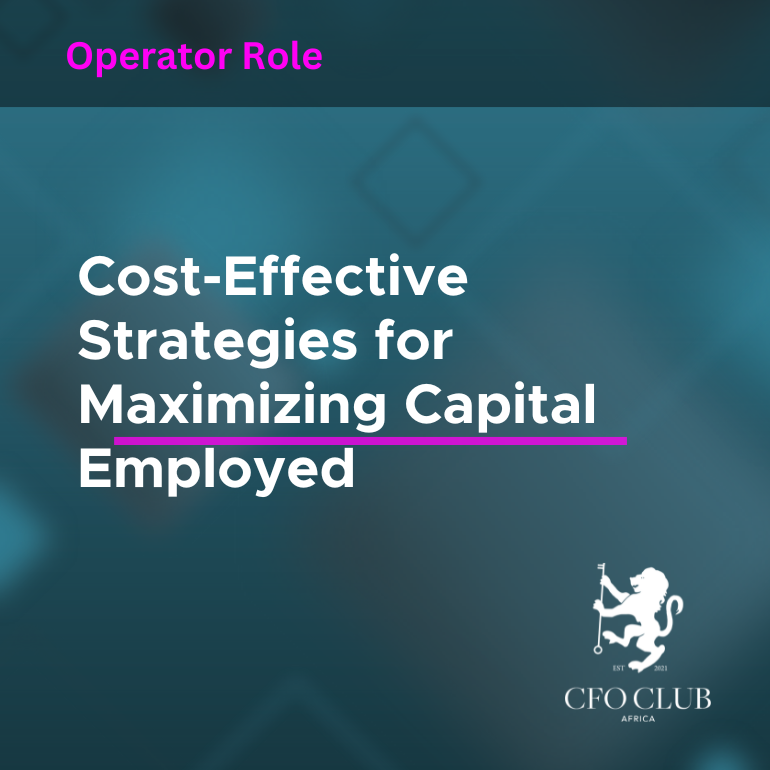Cost-Effective Strategies for Maximizing Capital Employed
As a CFO, one of the critical tasks is to ensure that capital employed in your business is used efficiently to generate the highest possible returns. Maximizing capital employed doesn’t always require hefty investments; instead, you can use cost-effective strategies to ensure that every rand works hard for the company. Here are some practical approaches that CFOs can implement to make the most of capital employed.
1. Optimise Working Capital Management
Efficient working capital management can significantly boost the return on capital employed (ROCE). Focus on the following areas:
- Inventory Management: Avoid overstocking, which ties up capital unnecessarily. Use demand forecasting and just-in-time (JIT) inventory practices to keep inventory lean without risking shortages.
- Receivables Management: Reduce the average collection period by setting clear payment terms, offering early payment discounts, or using invoice factoring if necessary.
- Payables Management: Delay payments without damaging supplier relationships. Negotiate longer credit terms to free up cash flow without incurring penalties.
Regularly review your working capital metrics and establish benchmarks to ensure improvement. Set targets for your days sales outstanding (DSO) and days inventory outstanding (DIO) to better manage your cash cycle.
2. Leverage Asset Utilisation
Maximizing the usage of your assets ensures that the capital employed in assets delivers maximum value. Here’s how:
- Monitor Asset Efficiency: Regularly track key performance indicators (KPIs) related to asset utilisation, such as turnover ratios. If machinery or equipment is underutilised, consider redeploying them or leasing them out.
- Outsource Non-Core Activities: If certain assets, like transport vehicles or warehouse space, are not core to your business, outsource those functions. This allows the company to free up capital that can be employed in high-return areas.
Conduct an asset utilisation audit to determine which assets can be better used, sold, or leased.
3. Focus on Return-Generating Investments
Not all investments yield the same returns. Prioritise capital expenditures (CapEx) that provide the highest ROCE:
- Identify High-Yield Projects: Focus on investments that directly contribute to revenue growth or cost savings. For instance, upgrading to energy-efficient equipment could lower operating costs, resulting in long-term savings.
- Use Data Analytics for Decision Making: Leverage financial data to assess the return potential of different projects before committing capital. Look beyond immediate gains and consider long-term benefits.
Before greenlighting any new project, use a weighted scoring system that evaluates the potential return, risk, and alignment with company goals.
4. Refinance High-Cost Debt
Debt can be a double-edged sword. While borrowing can provide capital for growth, high-interest loans can quickly eat into your profits:
- Refinance at Lower Interest Rates: If your company has old debt at higher interest rates, consider refinancing options that offer lower rates. This reduces the cost of capital employed.
- Balance Debt and Equity: Maintain a healthy balance between debt and equity. Too much reliance on debt increases financial risk, but too little debt can prevent the company from expanding.
Regularly review your debt structure to identify refinancing opportunities, especially during periods of lower interest rates.
5. Implement Cost Control Mechanisms
Reducing unnecessary costs can improve ROCE without needing additional capital. Focus on:
- Process Improvements: Use lean management or Six Sigma techniques to streamline operations, cut waste, and reduce costs. This ensures that capital is employed efficiently in generating value.
- Automate Where Possible: Invest in automation to reduce manual processes and increase productivity. Though automation requires upfront capital, it pays off by improving efficiency in the long run.
Regularly audit your business processes for inefficiencies and explore technological solutions to automate repetitive tasks.
6. Strategic Divestments
If certain business units or assets are underperforming, consider divesting from them. Divestments can free up capital that can be better employed in areas that generate higher returns.
- Sell Non-Core Assets: Identify non-core assets that don’t contribute significantly to the company’s objectives. Selling these assets frees up capital for reinvestment in growth areas.
- Exit Underperforming Ventures: If a business unit is draining resources without delivering expected returns, it may be time to divest and focus on more profitable areas.
Conduct an annual portfolio review to assess each business unit’s profitability and strategic value. Divest when necessary to optimise capital employed.
7. Boost Human Capital Efficiency
Your workforce is one of the most significant investments. Ensuring that employees are working efficiently is key to maximizing returns on capital:
- Training and Development: Investing in employee skills improves productivity. Consider offering targeted training programs that equip your team with the necessary skills to do their jobs more efficiently.
- Align Incentives with Performance: Ensure that employee incentives align with company goals. A performance-based bonus structure can motivate employees to contribute to the company’s overall success.
Use key performance indicators (KPIs) to measure employee productivity and assess whether further training or incentives are required.
Conclusion
Maximizing capital employed doesn’t require drastic measures. By focusing on optimising working capital, leveraging assets effectively, making smarter investments, controlling costs, and refining your approach to debt, CFOs can significantly boost their company’s returns. Implementing these cost-effective strategies can ensure that every rand is well-spent, positioning your company for sustained growth and profitability.

